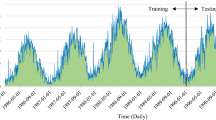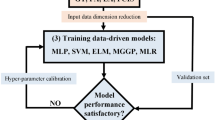Abstract
This paper investigates the ability of linear genetic programming (LGP), which is an extension to genetic programming (GP) technique, in daily pan evaporation modeling. The daily climatic data, air temperature, solar radiation, wind speed, pressure and humidity of three automated weather stations, Fresno, Los Angeles and San Diego in California, are used as inputs to the LGP to estimate pan evaporation. The LGP estimates are compared with those of the Gene-expression programming (GEP), which is another branch of GP, multilayer perceptrons (MLP), radial basis neural networks (RBNN), generalized regression neural networks (GRNN) and Stephens–Stewart (SS) models. The performances of the models are evaluated using root mean square errors (RMSE), mean absolute error (MAE) and determination coefficient (R 2) statistics. Based on the comparisons, it was found that the LGP technique could be employed successfully in modeling evaporation process from the available climatic data.



Similar content being viewed by others
References
Akaike H (1973) Information theory and an extension of the maximum likelihood principle. In: Petrov BN, Csaki F (eds) Proc., 2nd Int. Symp. on information Theory. Academiai Kiado, Budapest, Hungary, pp 267–281
Al-Ghobari HM (2000) Estimation of reference evapotranspiration for southern region of Saudi Arabia. Irrig Sci 19(2):81–86
Aytek A, Kisi O (2008) A genetic programming approach to suspended sediment modeling, J. Hydrology 351(3–4):288–298
Babovic V, Keijzer M (2002) Declarative and preferential bias in GEP-based scientific discovery. Genet Program Evolvable Mach 3(1):41–79
Banzhaf W, Nordin P, Keller RE, Francone FD (1998) Genetic programming: an introduction. Morgan Kaufmann, San Francisco
Brameier M (2004) On linear genetic programming. Ph.D. thesis. University of Dortmund
Brameier M, Banzhaf W (2001) A comparison of linear genetic programming and neural networks in medical data mining. IEEE Trans Evol Comput 5:17–26
Brutsaert WH (1982) Evaporation into the atmosphere. D. Reidel Publishing Company, Dordrecht
Dorado J, Rabunal JR, Pazos A, Rivero D, Santos A, Puertas J (2003) Prediction and modeling of the rainfall-runoff transformation of a typical urban basin using ANN and GP. Appl Artif Intell 17:329–343
Ferreira C (2001a) Gene expression programming in problem solving. In: Proceedings of the 6th online world conference on soft computing in industrial applications (invited tutorial)
Ferreira C (2001b) Gene expression programming: a new adaptive algorithm for solving problems. Complex Syst 13(2):87–129
Giustolisi O (2004) Using genetic programming to determine Chezy resistance coefficient in corrugated channels. J Hydroinformatics 6(3):157–173
Gundekar HG, Khodke UM, Sarkar S, Rai RK (2008) Evaluation of pan coefficient for reference crop evapotranspiration for semi-arid region. Irrig Sci 26(2):169–175
Guven A (2009) Linear genetic programming for time-series modeling pf daily flow rate. J Earth Syst Sci 118(2):137–146
Guven A, Aytek A (2009) New approach for stage-discharge relationship: gene-expression programming. J Hydrol Eng 14(8):812–820
Guven A, Gunal M (2008a) Prediction of scour downstream of grade-control structures using neural networks. J Hydraulic Eng 134(11):1656–1660
Guven A, Gunal M (2008b) Genetic programming for prediction of local scour downstream of grade-control structures. J Irrig Drainage Eng 134(2):241–249
Guven A, Kişi Ö (2009) Suspended sediment modeling using linear genetic modeling. Hydrol Sci J (under review)
Guven A, Gunal M, Cevik A (2006) Prediction of pressure fluctuations on stilling basins. Can J Civil Eng 33(11):1379–1388
Guven A, Aytek A, Yuce MI, Aksoy H (2007) Genetic programming-based empirical model for daily reference evapotranspiration estimation. Clean-Soil Air Water 36(10–11):905–912
Guven A, Azamathulla HMd, Zakaria NA (2009) Linear genetic programming for prediction of circular pile scour. J Ocean Eng 36(12–13):985–991
Keskin ME, Terzi O (2006) Artificial neural network models of daily pan evaporation. J Hydrol Eng 11(1):65–70
Kisi O (2009a) Daily pan evaporation modeling using multi-layer perceptrons and radial basis neural networks. Hydrol Process 23:213–223
Kisi O (2009b) Modeling monthly evaporation using two different neural computing techniques. Irrig Sci 27(5):417–430
Koza JR (1992) Genetic programming: on the programming of computers by means of natural selection. The MIT Press, Cambridge
Kumar M, Bandyopadhyay A, Raghuwanshi NS, Singh R (2008) Comparative study of conventional and artificial neural network-based ETo estimation models. Irrig Sci 26(6):531–545
Nordin P (1994) A compiling genetic programming system that directly manipulates the machine-code. In: Kinnear KE (ed) Advances in genetic programming. MIT Press, Cambridge, pp 311–331
Nordin P (1997) Evolutionary program induction of binary machine code and its applications. Ph.D. dissertation: Dept. Comput. Sci., Univ. Dortmund
Nordin P, Banzhaf W (1995) Evolving turing-complete programs for a register machine with self-modifying code. In: Eshelman L (ed) Proceedings of the 6th international conference of genetic algorithms. Morgan Kaufmann, Pittsburgh, PA, USA, pp 318–325
Oltean M, Grosan C (2003) A comparison of several linear genetic programming techniques. Complex Syst 14(1):1–29
Rabunal JR, Puertas J, Suarez J, Rivero D (2007) Determination of the unit hydrograph of a typical urban basin using genetic programming and artificial neural networks. Hydrol Process 21:476–485
Rahimikhoob A (2009) An evaluation of common pan coefficient equations to estimate reference evapotranspiration in a subtropical climate (north of Iran). Irrig Sci 27(4):289–296
Rissanen J (1978). Modeling by the shortest data description. Automatica 14:465–471
Stephens JC, Stewart EH (1963) A comparison of procedures for computing evaporation and evapotranspiration. Publication 62, international association of scientific hydrology. International Union of Geodynamics and Geophysics, Berkeley, CA, pp 123–133
Tabari H, Marofi S, Sabziparvar A-A (2010) Estimation of daily pan evaporation using artificial neural network and multivariate non-linear regression. Irrig Sci 28(5):399–406. doi:10.1007/s00271-009-0201-0
Whigham PA, Crapper PF (2001) Modeling rainfall-runoff using genetic programming. Math Comput Model 33:707–721
Author information
Authors and Affiliations
Corresponding author
Additional information
Communicated by S. Azam-Ali.
Rights and permissions
About this article
Cite this article
Guven, A., Kişi, Ö. Daily pan evaporation modeling using linear genetic programming technique. Irrig Sci 29, 135–145 (2011). https://doi.org/10.1007/s00271-010-0225-5
Received:
Accepted:
Published:
Issue Date:
DOI: https://doi.org/10.1007/s00271-010-0225-5




